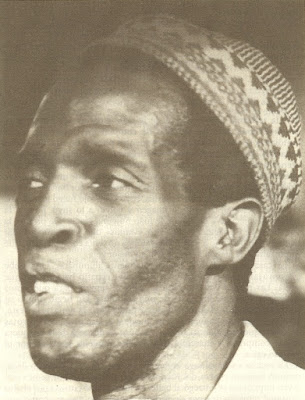We heard from El Goyo today (June 02, 2007) this sad news:
"Hoy a 4a.m falleció Mario Dreke Alfonso ( Chavalonga )."
("Today at 4 am Mario Dreke Alfonso "Chavalonga" passed away.")
We will be writing more about Chavalonga once we can confirm the news, in the meantime we'll take a moment to reflect on the work of this great rumbero.
Most readers will be familiar with him from his classic performances on "Rapsodia Rumbera," especially "Palo Quimbombó." He also released his own album on the Envidia label, "El rey de la Tahona."
He also led the groups "Ven Tu, Rumbero" (also known in another incarnation - without Chavalonga - as "Wemilere") and "Agüiri Yo."
Helio Orovio, in "Cuban Music A to Z," writes:
"Dreke, Mario ("Chavalonga"): Author, singer, dancer, musician. Born 25 April 1925, Havana. Since the 1940s Chavalonga has been considered one of the most outstanding performers of African rhythms and rumba. Among his most popular guaguancós are "Palo quimbombó," "Los barrios unidos," "Muñequita," and "Oye lo que te voy a decir." He was a founder of the National Folkloric Ensemble [Conjunto Folklorico Nacional] and is currently the director of a company carrying his name."
Maria del Carmen Mestas, a cuban writer who has done more than anyone lately to document the biographies of rumberos, published piece about him recently here. (The piece was adapted from the chapter on Chavalonga in her (highly recommended) book "Pasión de Rumbero."
Below is my translation of her article:
Memories of a rumbero
MARIA DEL CARMEN MESTAS
If you walk through the Havana district of Atarés it's possible you will see Chavalonga, a "street encyclopedia" of rumba. Chava, as his friends like to call him, has seen many moons pass in his tired heart, but if drum is heard he is the first one in dancing.
The night traveled in the light of thousands of stars. The scent of the leafy lemon tree competed with one of jasmins. Skinny, with a brilliant glance, the youngster entered the circle. The drums exerted their ancestral spell so that Chavalonga gave a skillful dissertation when dancing to a well-known guaguancó. It had not finished and even still many were applauding. "Avemaría! Yeah! He's fenomenal!" said the queen of jolgorio, Andrea Baró, with astonished eyes, while Carburo predicted, "Boy, you will be great!"
"Yes, back then in Jovellanos, Matanzas, I was consecrated", exclaims Mario "Chavalonga" Dreke proudly, one of our great rumberos, when remembering that happy beginning in a genre to which he has brought his creativity to dance, song and percussion.
A LIFE, A RUMBERO
Rumba has always accompanied Chavalonga, and together they've lived moments of great joys and others of secret pain. This mythical figure has worked the genre from its deepest root, giving it an expression uniquely his; that is to say, creating a style that identifies him.
It's certain that his first rumba was savored "very small, because as soon as I opened my eyes I heard the drum, and if to others they sang it to sleep with lullabies, mine was with that sound that can be as sweet as honey.
My family is from Limonar province in Matanzas, and when Christmas Eve arrived, everyone who could came to my house, to "the judgement," as the rumberos called it; the same
he appeared one of Carlos Rojas, who was from Jovellanos or Jagüey, and from different municipalities. So it was that I got started in this music, drinking from that which the stars made: Carburo, Sagua, El Dinde, Celestine Domec, Jimagua and others.
"That was my world since I was very small, and I love it because it's a part of my life that, by the way, was very risky. I couldn't exist without music because it is as if I lacked eyes to see or my voice to sing.
"I worked with Chano Pozo in a cabaret that was called... something like
Spotwind, and also in comparsas, that was our diversion. All year we were waiting for the carnavales to arrive and prepared ourselves by rehearsing.
With Chano I learned to play the drum; now I dance and sing with seven. He was a very guarachero type, happy, but the atmosphere dominated him and he took the wrong path.
"I participated in the film "Sucedió en La Habana," and I went to Mexico, where I acted in films with the comic actress Vitola [Famie Kaufman], but I became ill because the hot spices hurt me (I do not know if it was really that, or because I carried the weight of nostalgia in my heart). I came back on the boat "Lucero del Alba."
If someone has been in Chavalonga's memory it is Benny Moré, with whom I worked in the Molino Rojo and other places in the federal district. "Benny is always in my thoughts: a man who gave it all. His thing was to sing, to throw his wonderful voice to the wind... "
Creator of the Tahona rhythm and inspired composer of boleros in the guaguancó style, Chavalonga also appears in other films as "La última cena," "Rapsodia abakuá," the documentary about Tío Tom, "La rumbera" and "La historia del negro rumbero Mario Chavalonga."
Chavalonga is a founder of the Conjunto Folclórico Nacional, where he not only contributed his knowledge, he also extended his own to master other genres like the songs of the Yoruba, Lucumí, Arará, Carabalí...
With that famous group he traveled to many countries; the greatest successes of the rumbero were in Brazil, where he sang the prayer to Shangó and was highly applauded, and in Algeria, when we was inspired to compose the number "Los Gorritos."
Brother of another famous rumbero, Enrique Dreke, El Príncipe Bailarín, my friend Chavalonga doesn't stop playing the drum, dancing the best steps, and remembering his youth full of great rumbas.
We'll leave with this clip of an interview, from a documentary called "Para Bailar La Habana" which aired on Greek television:

No comments:
Post a Comment